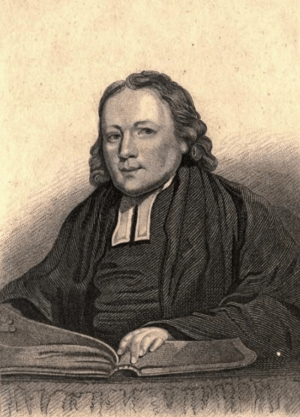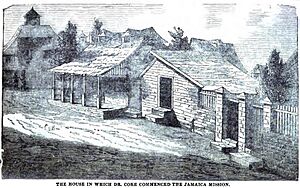Thomas Coke (bishop) facts for kids
Quick facts for kids
Thomas Coke
|
|
|---|---|
 |
|
| President of the Methodist Conference | |
| In office 1797–1798 |
|
| Preceded by | Thomas Taylor |
| Succeeded by | Joseph Benson |
| In office 1805–1806 |
|
| Preceded by | Henry Moore |
| Succeeded by | Adam Clarke |
| Personal details | |
| Born | 9 September 1747 Brecon, South Wales |
| Died | 2 May 1814 (aged 66) |
| Occupation | Methodist bishop |
Thomas Coke (born September 9, 1747, died May 2, 1814) was a very important leader in the Methodist Church. He was the first Methodist bishop. Thomas Coke was born in Brecon, Wales. He became a priest in 1772. However, he was asked to leave his church in South Petherton because he was a Methodist.
Coke met John Wesley, a founder of Methodism, in 1776. Later, Coke helped start Methodism in America. He also set up Methodist missions around the world. These missions helped spread the Methodist faith in the 1800s.
Contents
Early Life and Education
Thomas Coke was born in Brecon, a town in South Wales. His father, Barthomolew, was a wealthy pharmacist. Thomas Coke was not very tall, about 5 feet 1 inch. He also tended to gain weight easily.
He studied law at Jesus College, Oxford, which is part of the University of Oxford. This college has strong ties to Wales. He earned his first degree, a Bachelor of Arts, and then a Master of Arts in 1770. In 1775, he earned a Doctor of Civil Law degree. When he returned to Brecon, he served as the town's mayor in 1772.
Becoming a Priest and Methodist
In 1772, the same year he was mayor, Thomas Coke became a priest in the Church of England. He worked as a curate in South Petherton, a town in Somerset, England. He had already become interested in the Methodist movement. This caused problems when a new rector, or head priest, came to his church.
Coke had started holding church services in people's homes. He also preached outdoors, just like John Wesley did. Because of this, he was fired from his job on Easter Sunday in 1777. His parishioners, or church members, celebrated his dismissal. They rang the church bells and opened a large barrel of cider. Years later, in 1807, Coke returned to Petherton and preached to a crowd of 2,000 people.
Meeting John Wesley
Thomas Coke met John Wesley in August 1776. He quickly became one of Wesley's closest helpers. Wesley even called Coke "the flea." This was because Coke was always traveling around on his missions.
In 1780, Coke was put in charge of the London District for the Methodists. In 1782, he became the President of the Methodist Church in Ireland. He held this important role many times over the next few decades.
Plans for Missions Abroad
In January 1784, Thomas Coke worked with Thomas Parker. Parker was a lawyer and a good local preacher from York. Together, they created a "Plan of the Society for the Establishment of Missions among the Heathens." This plan showed their early ideas for sending missionaries to other countries.
Voyage to America
After the American Revolution, many Anglican priests in America went back to England. John Wesley asked the Bishop of London to ordain, or officially appoint, new ministers for America. But the bishop said no. At that time, Wesley believed only a bishop could appoint new priests.
However, in September 1784, in Bristol, England, Wesley appointed Coke as a "Superintendent." In America, this title changed to "Bishop" in 1787. Wesley did not like the title "Bishop" for Coke. Since Coke was already a priest in the Church of England, some people saw this appointment as making him a bishop.
Coke then sailed to New York. During his trip, he read many books. These included books by Augustine and Virgil. He also read about famous missionaries like Francis Xavier and David Brainerd.
In Baltimore, a meeting of Methodist preachers began on Christmas Day 1784. At this meeting, Coke and Francis Asbury were chosen as superintendents. The Methodist Church in America became an independent church, called the Methodist Episcopal Church. On December 27, Coke appointed deacons and presbyters. He also officially made Asbury a Superintendent. Coke and Asbury are seen as the first leaders of the Methodist Church in America. The American Methodist Conference officially used the title "Bishop" in 1787.
Other Journeys
Coke returned to England in June 1785. He made eight more trips to America, with his last visit in 1803. While in America, he spoke out against slavery. He even wrote a letter about it to George Washington, who was the first U.S. President. Washington met Coke twice and invited him to speak to the U.S. Congress.
After traveling in Great Britain and Ireland, Coke made his first mission trip to the West Indies in 1786. He visited the West Indies again in 1788–89, 1790, and 1792–93.
After Wesley's Death
John Wesley died in 1791. After his death, Thomas Coke became the Secretary of the British Methodist Conference. Many people thought Wesley wanted Coke to be his successor. Coke was President of the Conference in 1797 and 1805. Both times, he tried to convince the Conference to officially call him a Bishop.
More Travels for Missions
In 1803, Coke went to Paris, France, and preached in French. He started a mission in Gibraltar in 1803. Then he spent five years traveling to support Methodist missions. This included a visit to Sierra Leone in Africa. He also encouraged others to start missions in Canada and Scotland.
Marriages
On April 1, 1805, when he was 58 years old, Coke married Penelope Goulding Smith. She was a wealthy woman who was happy to use her money to help the missions. She traveled with him until she died on January 25, 1811. In December of the same year, he married again to Anne Loxdale. His second wife died the next year, on December 5, 1812.
Death of Thomas Coke
Thomas Coke wanted to start Methodist missions in the East Indies. He paid for his own trip and set sail for Ceylon (now Sri Lanka) on December 30, 1813. He had even tried to convince the Prime Minister, Lord Liverpool, to make him a bishop in the Church of England in India.
However, Coke died after four months at sea on his way to Ceylon. It is believed he died from a stroke. He passed away on the ship in the Indian Ocean. He was buried at sea.
Francis Asbury described Coke as "a gentleman, a scholar, a bishop to us; and as a minister of Christ, in zeal, in labours, in services, the greatest man in the last century."
See also
- List of bishops of the United Methodist Church



